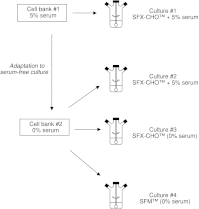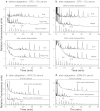Related effects of cell adaptation to serum-free conditions on murine EPO production and glycosylation by CHO cells
- PMID: 19002864
- PMCID: PMC3449423
- DOI: 10.1007/s10616-006-9039-y
Related effects of cell adaptation to serum-free conditions on murine EPO production and glycosylation by CHO cells
Abstract
The necessity to perform serum-free cultures to produce recombinant glycoproteins generally requires an adaptation procedure of the cell line to new environmental conditions, which may therefore induce quantitative and qualitative effects on the product, particularly on its glycosylation. In previous studies, desialylation of EPO produced by CHO cells was shown to be dependent on the presence of serum in the medium. In this paper, to discriminate between the effects of the adaptation procedure to serum-free medium and the effects of the absence of serum on EPO production and glycosylation, adapted and non-adapted CHO cells were grown in serum-free and serum-containing media. The main kinetics of CHO cells were determined over batch processes as well as the glycosylation patterns of produced EPO by HPCE-LIF. A reversible decrease in EPO production was observed when cells were adapted to SFX-CHO(TM) medium, as the same cells partially recovered their production capacity when cultivated in serum-containing medium or in the enriched SFM(TM) serum-free medium. More interestingly, EPO desialylation that was not observed in both serum-free media was restored if the serum-independent cells were recultured in presence of serum. In the same way, while the serum-independent cells did not release a sialidase activity in both serum-free media, a significant activity was recovered when serum was added. In fact, the cell adaptation process to serum-free conditions did not specifically affect the sialidase release and the cellular mechanism of protein desialylation, which appeared to be mainly related to the presence of serum for both adapted and non-adapted cells.
Figures




Similar articles
-
HPCE monitoring of the N-glycosylation pattern and sialylation of murine erythropoietin produced by CHO cells in batch processes.Biotechnol Prog. 2004 May-Jun;20(3):864-71. doi: 10.1021/bp0343211. Biotechnol Prog. 2004. PMID: 15176893
-
Enhancement of recombinant human EPO production and glycosylation in serum-free suspension culture of CHO cells through expression and supplementation of 30Kc19.Appl Microbiol Biotechnol. 2012 Nov;96(3):671-83. doi: 10.1007/s00253-012-4203-0. Epub 2012 Jun 20. Appl Microbiol Biotechnol. 2012. PMID: 22714097
-
Characterization of intact glycopeptides reveals the impact of culture media on site-specific glycosylation of EPO-Fc fusion protein generated by CHO-GS cells.Biotechnol Bioeng. 2019 Sep;116(9):2303-2315. doi: 10.1002/bit.27009. Epub 2019 May 29. Biotechnol Bioeng. 2019. PMID: 31062865 Free PMC article.
-
CHO glycosylation mutants as potential host cells to produce therapeutic proteins with enhanced efficacy.Adv Biochem Eng Biotechnol. 2013;131:63-87. doi: 10.1007/10_2012_163. Adv Biochem Eng Biotechnol. 2013. PMID: 23142953 Review.
-
Serum-Free Medium for Recombinant Protein Expression in Chinese Hamster Ovary Cells.Front Bioeng Biotechnol. 2021 Mar 15;9:646363. doi: 10.3389/fbioe.2021.646363. eCollection 2021. Front Bioeng Biotechnol. 2021. PMID: 33791287 Free PMC article. Review.
Cited by
-
Metabolic engineering of CHO cells for the development of a robust protein production platform.PLoS One. 2017 Aug 1;12(8):e0181455. doi: 10.1371/journal.pone.0181455. eCollection 2017. PLoS One. 2017. PMID: 28763459 Free PMC article.
-
Considerations for Glycoprotein Production.Methods Mol Biol. 2024;2762:329-351. doi: 10.1007/978-1-0716-3666-4_20. Methods Mol Biol. 2024. PMID: 38315375
-
Transcriptomic Insights Into Serum-Free Medium Adaptation and Temperature Reduction in Chinese Hamster Ovary Cell Cultures.Biotechnol J. 2025 Jul;20(7):e70055. doi: 10.1002/biot.70055. Biotechnol J. 2025. PMID: 40611689 Free PMC article.
-
Over-expression of a Codon Optimized Yeast Cytosolic Pyruvate Carboxylase (PYC2) in CHO Cells for an Augmented Lactate Metabolism.Front Pharmacol. 2017 Jul 17;8:463. doi: 10.3389/fphar.2017.00463. eCollection 2017. Front Pharmacol. 2017. PMID: 28769797 Free PMC article.
-
Next-generation sequencing of the Chinese hamster ovary microRNA transcriptome: Identification, annotation and profiling of microRNAs as targets for cellular engineering.J Biotechnol. 2011 Apr 20;153(1-2):62-75. doi: 10.1016/j.jbiotec.2011.02.011. Epub 2011 Mar 30. J Biotechnol. 2011. PMID: 21392545 Free PMC article.
References
LinkOut - more resources
Full Text Sources
Other Literature Sources
Research Materials

